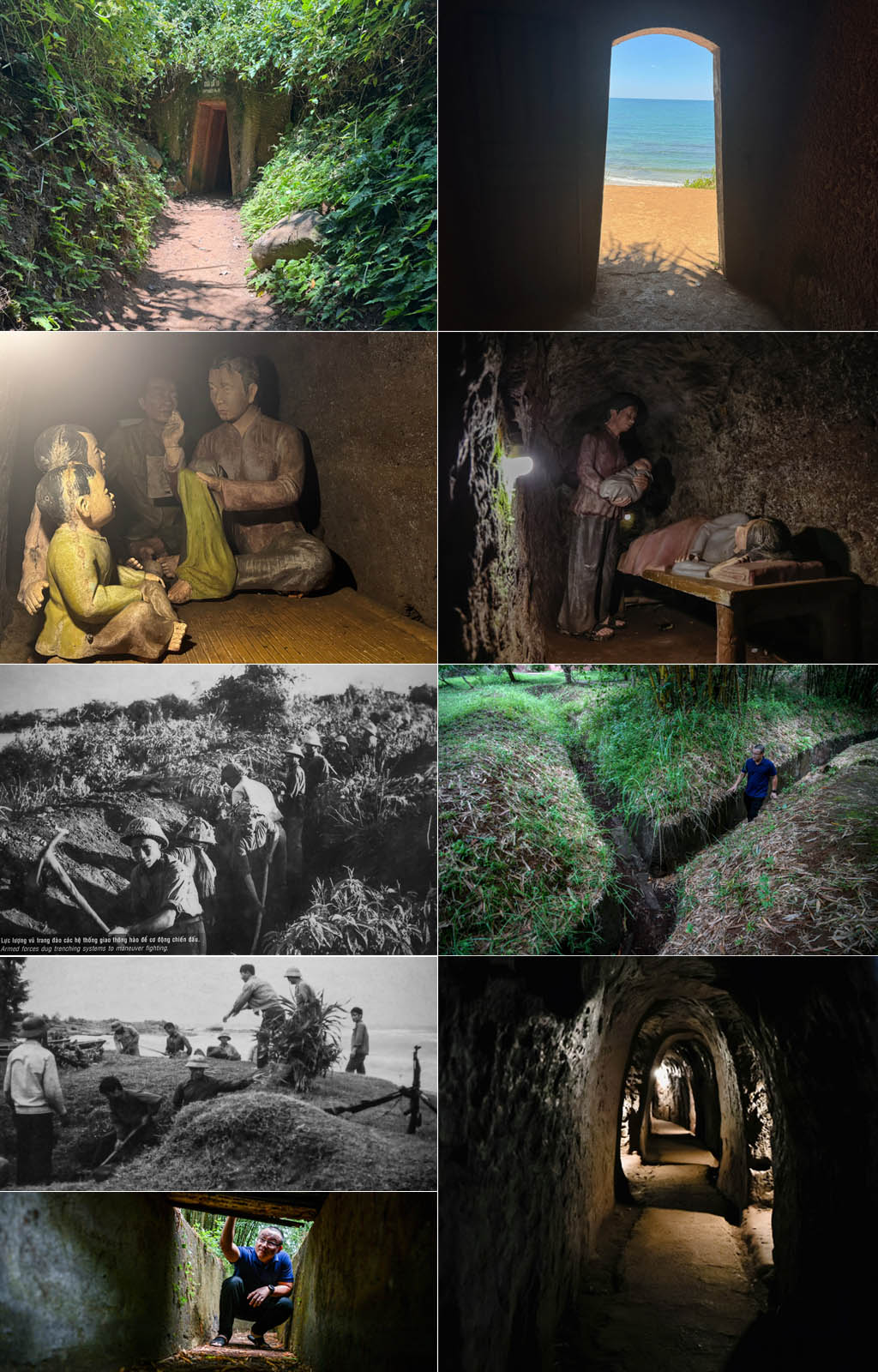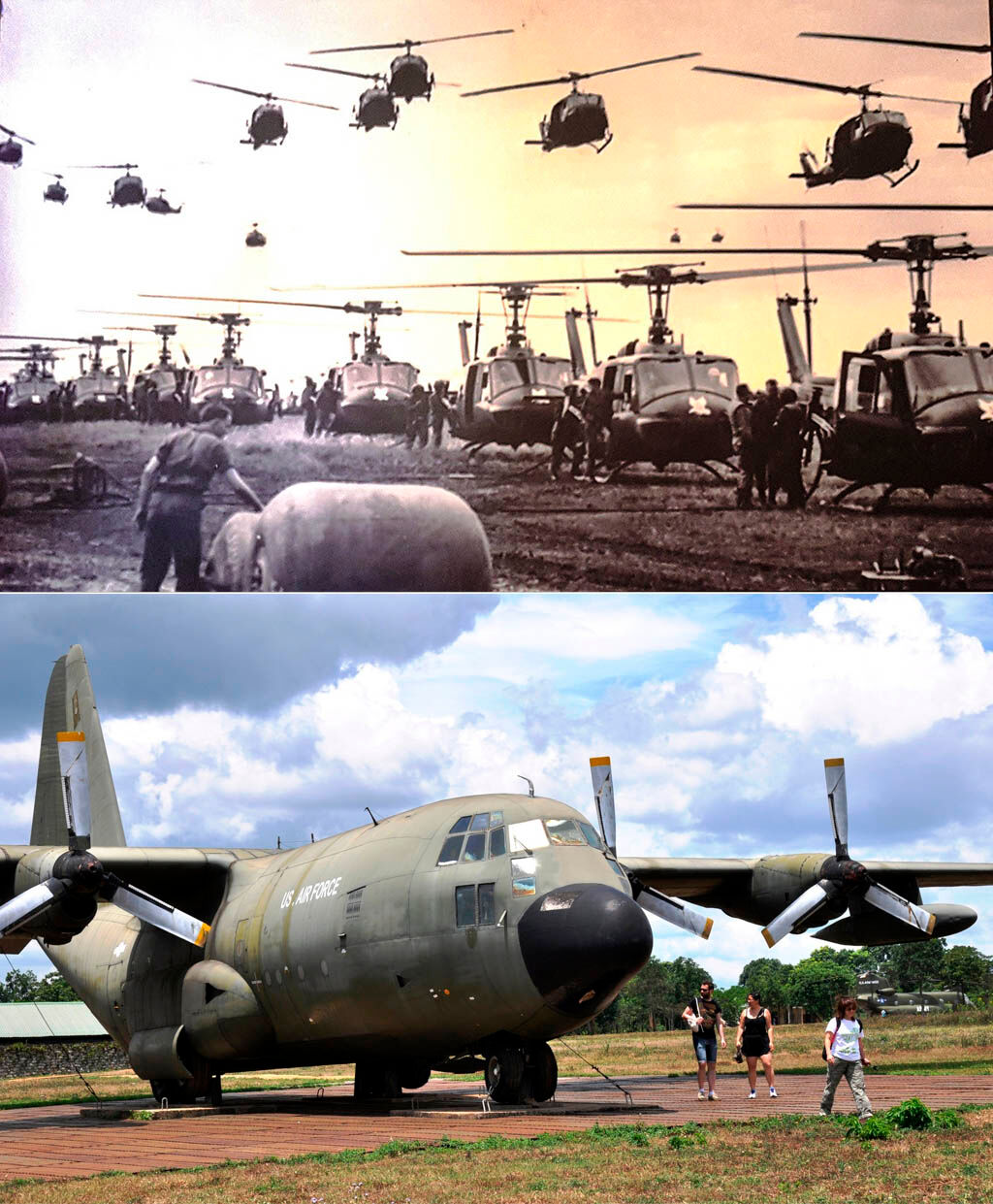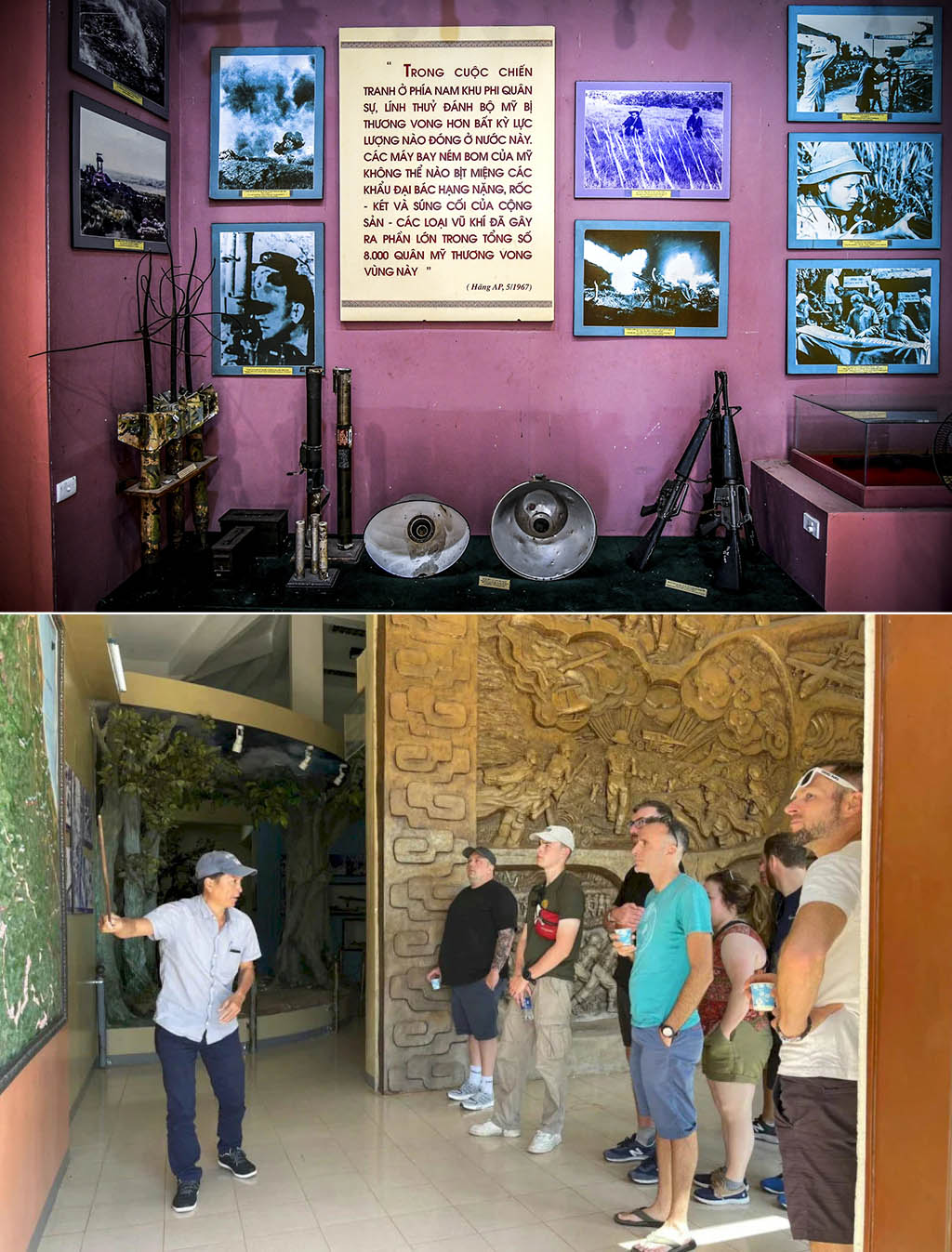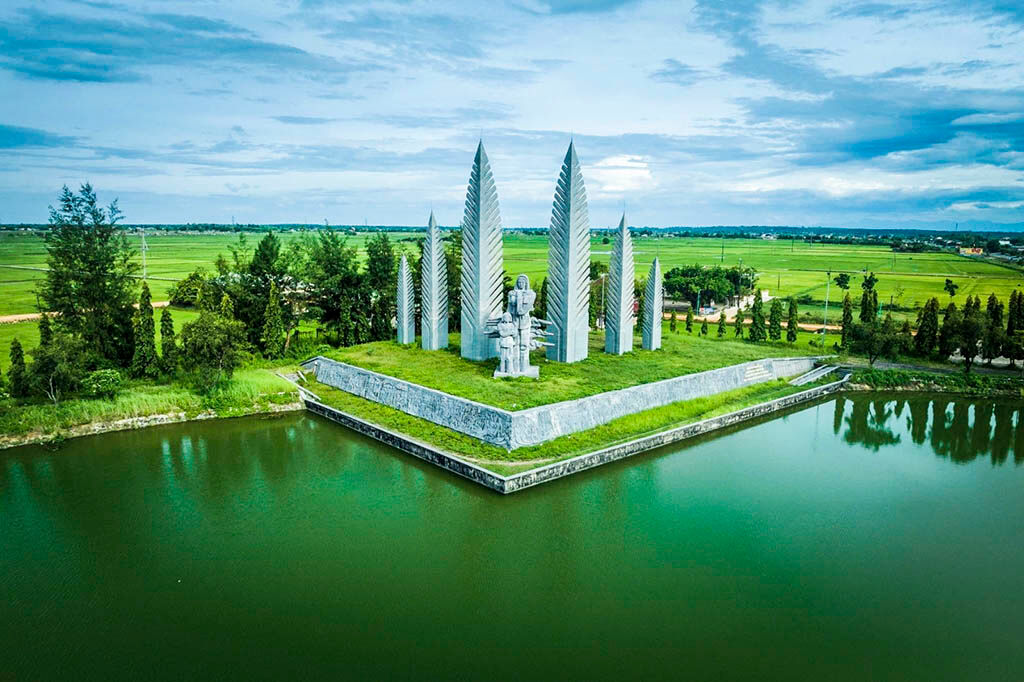Discover the Demilitarized Zone (DMZ) near Hue with our travel guide! Learn about its Vietnam War history, cultural etiquette, costs, top activities, and eco-friendly tips for a sustainable visit. Plan your historical journey today!
 Connect with the human stories of the DMZ’s past (Source: Internet)
Connect with the human stories of the DMZ’s past (Source: Internet)Written by Tony Bùi, with over 20 years of experience in the travel industry, guiding 1000+ travelers across Southeast Asia. This guide draws from firsthand insights, guest feedback from Legend Travel Group surveys, and official sources like vietnam.travel. Prices and schedules based on latest data; verify before travel. Updated August 2025, reflecting Vietnam’s administrative changes (34 provinces, streamlined local governance).
 Admire the enduring relics of Vietnam’s war history (Source: Internet)
Admire the enduring relics of Vietnam’s war history (Source: Internet)The Demilitarized Zone (DMZ) near Hue, located in Quang Tri Province, is a historically significant area that captivates visitors with its wartime relics, poignant memorials, and stories of resilience. Established in 1954 along the 17th parallel under the Geneva Accords, the DMZ, stretching 5 km on either side of the Ben Hai River, served as a buffer between North and South Vietnam during the Vietnam War (1954–1975). Approximately 100 km north of Hue, it includes key sites like Vinh Moc Tunnels, Khe Sanh Combat Base, and Hien Luong Bridge. From Hanoi or HCMC, reach Dong Ha by train (10-12 hours, $15–$40 or 375,000–1,000,000 VND), bus ($10–$20 or 250,000–500,000 VND), or flight (1.5 hours, $50–$120 or 1,250,000–3,000,000 VND), then transfer to the DMZ. Mastering Demilitarized Zone Hue cultural etiquette ensures respectful exploration, ideal for history enthusiasts, veterans, and eco-conscious travelers.
Following Vietnam’s administrative reform on July 1, 2025, Quang Tri remains a key province among the streamlined 34 provinces, enhancing access with improved eco-friendly transport like e-vans and e-bikes. This guide blends historical insights, cultural tips, and sustainable travel ideas for a meaningful visit.
The DMZ sites are generally open daily from 7:00 AM–5:00 PM. Located in the former Vinh Linh and Huong Hoa areas (now part of Quang Tri’s simplified administrative structure post-2025), they emphasize respectful conduct, especially as war memorials. Vietnam’s 2025 reform removes some district-level administration, making travel logistics smoother.
 Embrace the DMZ’s wartime legacy with respect (Source: Internet)
Embrace the DMZ’s wartime legacy with respect (Source: Internet)Created after the First Indochina War (1946–1954), the DMZ was intended as a neutral zone but became one of the most militarized areas during the Vietnam War, with an estimated 7 tons of bombs dropped per person. Key sites include the Vinh Moc Tunnels, a civilian shelter; Khe Sanh Combat Base, a U.S. Marine outpost besieged in 1968; and Hien Luong Bridge, symbolizing Vietnam’s division. The area saw fierce battles, including the 1972 Easter Offensive, leaving lasting scars like bomb craters and memorials. Today, it’s a place of reflection, with rice fields covering former battlegrounds and museums preserving wartime stories.
Cultural etiquette ensures respectful visits to this solemn region. Here’s your guide, based on current norms as of 2025:
Greetings: Offer “xin chào” (hello) or a nod to guides and staff; use both hands when exchanging tickets or donations to show respect.
Dress: Wear modest, comfortable clothing; a lightweight scarf ($3 or 75,000 VND) aligns with memorial norms.
Behavior: Speak softly to honor the sites’ significance; avoid touching artifacts, relics, or memorials; photography is allowed but be respectful near graves or shrines. A guest shared: “The DMZ’s history felt profound when we respected its solemnity.”
Customs: Entry fees vary ($1–$2 or 25,000–50,000 VND per site); small donations ($1–$2 or 25,000–50,000 VND) support preservation; follow guided paths to protect relics.
Tip: Say “cảm ơn” (thank you) to staff; avoid littering to support Quang Tri’s eco-initiatives. Tony Bùi notes: “In 20 years guiding, I’ve seen the DMZ’s stories move visitors who honor its wartime legacy.”
General Tips:
Language: Carry a phrase card ($2 or 50,000 VND) for Vietnamese basics like “bao nhiêu” (how much); Google Translate assists with communication.
Respect: Avoid loud conversations; respect veterans or locals visiting as pilgrims.
Navigation: Expect 6-11 hours for a full DMZ tour; download offline maps (Maps.me) with “Demilitarized Zone, Quang Tri” for easy access.
Eco-Tip: Use reusable water bottles ($4 or 100,000 VND) to reduce plastic waste, aligning with Quang Tri’s green tourism goals post-2025 reform.
Note: Etiquette reflects current norms; verify updates via vietnam.travel.
 Feel the historical weight of the DMZ’s Ho Chi Minh Trail (Source: Internet)
Feel the historical weight of the DMZ’s Ho Chi Minh Trail (Source: Internet)These budget-friendly, eco-conscious activities ($0–$10 entry, excluding transport) complement your DMZ visit:
Explore the underground civilian shelter, 37 km from Dong Ha.
Cost: $2 (50,000 VND, adults); free for kids under 12.
Hours: Daily, 7:00 AM–5:00 PM.
Eco-Friendly Note: Use e-vans ($15–$20 or 375,000–500,000 VND) to reduce emissions.
Tip: Wear sturdy shoes for tunnels; a guest noted: “Vinh Moc’s resilience deepened my DMZ experience.”
Explore the historic U.S. Marine outpost, 63 km from Dong Ha.
Cost: $2 (50,000 VND, adults); free for kids under 12.
Hours: Daily, 7:30 AM–5:30 PM.
Eco-Friendly Note: Use e-vans ($15–$20 or 375,000–500,000 VND) to reduce emissions.
Tip: Respect relics like tanks; a guest noted: “Khe Sanh’s history complemented the DMZ’s narrative.”
See the iconic bridge and river at the 17th Parallel, 25 km from Dong Ha.
Cost: Free; donations ($1–$2 or 25,000–50,000 VND).
Hours: Daily, 7:00 AM–5:00 PM.
Eco-Friendly Note: Cycle from Dong Ha (25 km, $5/day e-bike or 125,000 VND) to reduce emissions.
Tip: Respect the memorial; a guest noted: “Hien Luong’s symbolism added depth to my DMZ visit.”
Explore the fortress from the 1972 Fire Summer, 2 km from Dong Ha.
Cost: $1–$2 (25,000–50,000 VND).
Hours: Daily, 7:00 AM–5:00 PM.
Eco-Friendly Note: Walk or cycle from Dong Ha (2 km, $5/day e-bike or 125,000 VND) to reduce emissions.
Tip: Wear modest clothing; a guest noted: “The citadel’s ruins enriched my DMZ tour.”
Explore the starting point of the Ho Chi Minh Trail, 50 km from Dong Ha.
Cost: Free; snacks ($1–$3 or 25,000–75,000 VND).
Hours: Open 24 hours; best visited 8:00 AM–4:00 PM.
Eco-Friendly Note: Use e-vans ($10–$15 or 250,000–375,000 VND) to reduce emissions.
Tip: Respect nearby Paco minority village; a guest noted: “Dakrong’s history paired well with the DMZ.”
March to August offers dry, warm weather (20–30°C), ideal for exploring the DMZ and its outdoor sites. Avoid September-January’s rainy season, which can make roads slippery and sites damp; March or April balances comfort and fewer crowds. Early mornings (7:00 AM–10:00 AM) are best for cooler weather and serene exploration.
 Honor Quang Tri’s legacy with reverence (Source: Internet)
Honor Quang Tri’s legacy with reverence (Source: Internet)Access the DMZ from major cities with eco-friendly options, enhanced by Vietnam’s 2025 administrative streamlining:
By Train: Hanoi-Dong Ha (10-12 hours, $15–$40 or 375,000–1,000,000 VND); HCMC-Dong Ha (20-22 hours, $25–$60 or 625,000–1,500,000 VND). From Dong Ha, take a taxi or tour van to DMZ sites ($15–$30 or 375,000–750,000 VND, 1-2 hours).
By Bus: Hanoi-Dong Ha ($10–$20 or 250,000–500,000 VND, 10 hours); HCMC-Dong Ha ($20–$30 or 500,000–750,000 VND, 22 hours). From Dong Ha, join a DMZ tour ($15–$30 or 375,000–750,000 VND).
By Air: Hanoi/HCMC-Hue ($40–$100 or 1,000,000–2,500,000 VND, 1 hour), then bus/taxi to Dong Ha ($15–$25 or 375,000–625,000 VND, 1.5 hours). Transfer: E-taxi or tour van from Dong Ha ($15–$30 or 375,000–750,000 VND).
Local: E-vans or e-bikes in Dong Ha ($5–$8/day or 125,000–200,000 VND). Navigation Tip: Save “Demilitarized Zone, Quang Tri” in offline maps (Maps.me). Parking: $0.50–$1 (12,500–25,000 VND).
Eco-Friendly Note: Group tours or e-vans reduce carbon footprint; book via 12go.asia.
Travel Tip: Morning tours (7:00 AM departure) avoid heat and crowds, with smoother logistics post-2025 reform.
Pack for respectful, sustainable exploration:
Documents: Passport, Vietnam e-visa ($25–$50 or 625,000–1,250,000 VND); wallet ($5–$8 or 125,000–200,000 VND).
Clothing: Modest, lightweight outfits; scarf ($3 or 75,000 VND); hat ($4 or 100,000 VND); comfortable shoes for tunnels and bases.
Essentials: Reusable water bottle ($4 or 100,000 VND); snacks ($1–$3 or 25,000–75,000 VND).
Tech: Phone with translation apps; charger ($10–$15 or 250,000–375,000 VND); local SIM ($5–$7 or 125,000–175,000 VND).
Eco Items: Reusable tote ($3 or 75,000 VND); phrase card ($2 or 50,000 VND).
Extras: Small VND for tickets/donations; sunscreen ($5 or 125,000 VND); insect repellent ($3 or 75,000 VND); flashlight ($3 or 75,000 VND) for tunnels. Tip: Comfortable shoes and modest attire enhance your experience at outdoor sites and memorials.
 Experience the DMZ’s historical serenity in solitude (Source: Internet)
Experience the DMZ’s historical serenity in solitude (Source: Internet)Transport Costs
Train: $15–$60 (375,000–1,500,000 VND) to Dong Ha.
Bus: $10–$30 (250,000–750,000 VND) to Dong Ha; $15–$30 (375,000–750,000 VND) for DMZ tours.
Flight: $40–$100 (1,000,000–2,500,000 VND) to Hue; $15–$25 (375,000–625,000 VND) to Dong Ha.
Local E-Van/E-Bike: $5–$8/day (125,000–200,000 VND).
Entry & Activity Costs
Vinh Moc Tunnels: $2 (50,000 VND, adults); free for kids under 12.
Khe Sanh Combat Base: $2 (50,000 VND, adults); free for kids under 12.
Hien Luong Bridge & Ben Hai River: Free; donations ($1–$2 or 25,000–50,000 VND).
Quang Tri Ancient Citadel: $1–$2 (25,000–50,000 VND).
Dakrong Bridge: Free; snacks ($1–$3 or 25,000–75,000 VND).
Souvenirs: $2–$6 (50,000–150,000 VND).
Eco-Tour Add-Ons: $15–$30 (375,000–750,000 VND).
Total Daily Cost (Per Person)
Budget: $20–$40 (bus, free sites, snacks).
Mid-range: $50–$80 (train, tunnels, combat base).
Luxury: $100–$150 (flight, guided tours). Tip: Budget $5–$10 for site entries, $15–$30 for DMZ tours, and $0–$10 for additional activities. Eco-options add historical depth.
Etiquette: Greet with “xin chào”; dress modestly; respect memorials and relics.
Transport: Group tours or e-vans for eco-travel; book DMZ tours in Dong Ha or Hue.
Schedules: Start tours early (7:00 AM–10:00 AM) for cooler weather and fewer crowds.
Sustainability: Use digital tickets and reusable items to support Quang Tri’s green goals.
Navigation: E-taxis or e-vans from Dong Ha ($15–$30 or 375,000–750,000 VND).
Weather: Dry season (March-August) ideal for outdoor sites; bring rain gear for unexpected showers.
Cultural Note: Maintain silence near memorials to honor the DMZ’s wartime legacy.
How much is entry to DMZ sites? Most sites cost $1–$2 (25,000–50,000 VND); some, like Hien Luong Bridge, are free with donations.
Is photography allowed? Yes, but be respectful near memorials and avoid flash in museums.
Are the DMZ sites suitable for all visitors? Tunnels may be challenging for those with claustrophobia; inform guides of concerns.
Are there eco-friendly tours? Many operators offer e-van or e-bike tours to reduce emissions; check 12go.asia.
How to handle crowds? Book early morning tours (7:00 AM) for a serene experience.
Enhance your DMZ visit with eco-conscious tours from Legend Travel Group, blending cultural respect and sustainability:
DMZ Eco-Tour ($80–$120/person, 1 day): E-van exploration of Vinh Moc Tunnels, Khe Sanh Combat Base, and Hien Luong Bridge, with eco-meals.
Quang Tri Historical Trail ($150–$200/person, 2 days): Visit DMZ sites, Quang Tri Citadel, and Dakrong Bridge with low-emission vans and cultural guides.
Central Vietnam Explorer ($300–$400/person, 3 days): Multi-site adventure with eco-lodges and community-focused activities.
Prices include guides, transport, and fees; group discounts available. Explore options at legendtravelgroup.com or contact sales@legendtravelgroup.com / WhatsApp +84825862222.
Exploring the Demilitarized Zone Hue with cultural etiquette—modest dress, polite greetings like “xin chào,” and respectful silence—unlocks Quang Tri’s profound Vietnam War history. With affordable entries ($1–$2), eco-friendly e-vans ($5–$8/day), and key sites like Vinh Moc Tunnels and Khe Sanh Combat Base, the DMZ offers history and sustainability. Whether visiting solo or joining guided eco-tours, prioritize respect for an unforgettable journey. Legend Travel Group’s Hue Tours guide you through Demilitarized Zone Hue, ensuring a sustainable Hue Travel experience filled with meaningful exploration. Don’t miss out—browse our featured tours and book your eco-journey today!
Ready to uncover Demilitarized Zone Hue’s historical wonders? Reserve your sustainable tour with Legend Travel Group and embark on an unforgettable adventure!
Author Bio: Written by Tony Bùi, with over 20 years of experience in the travel industry, guiding 100,000+ travellers across Southeast Asia. This guide draws from firsthand insights, guest feedback from Legend Travel Group surveys.
Source: By Tony Bùi at Legend Travel Group.
Favorite experiences booked by travelers